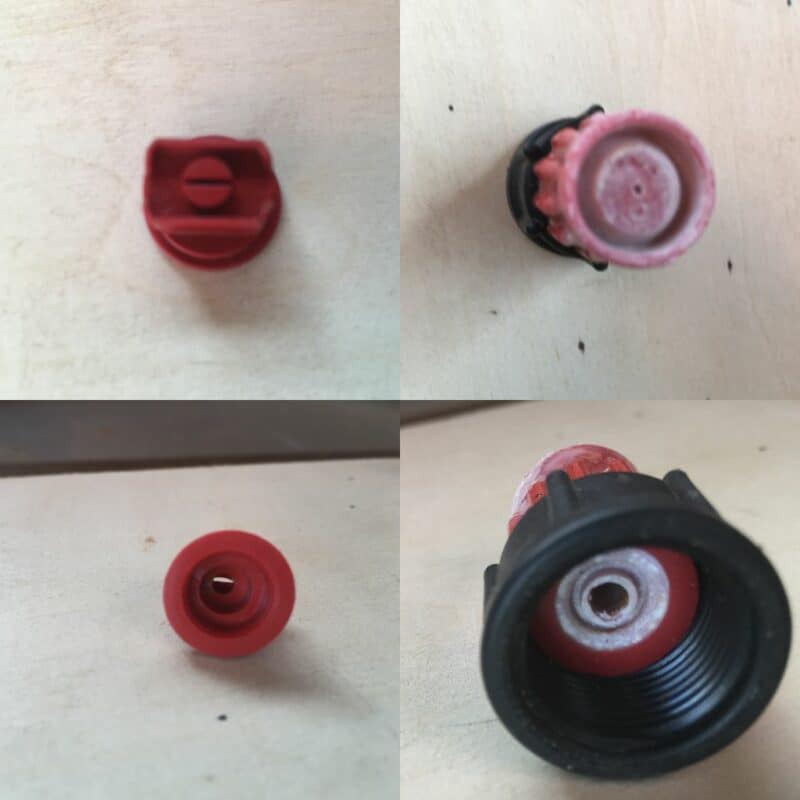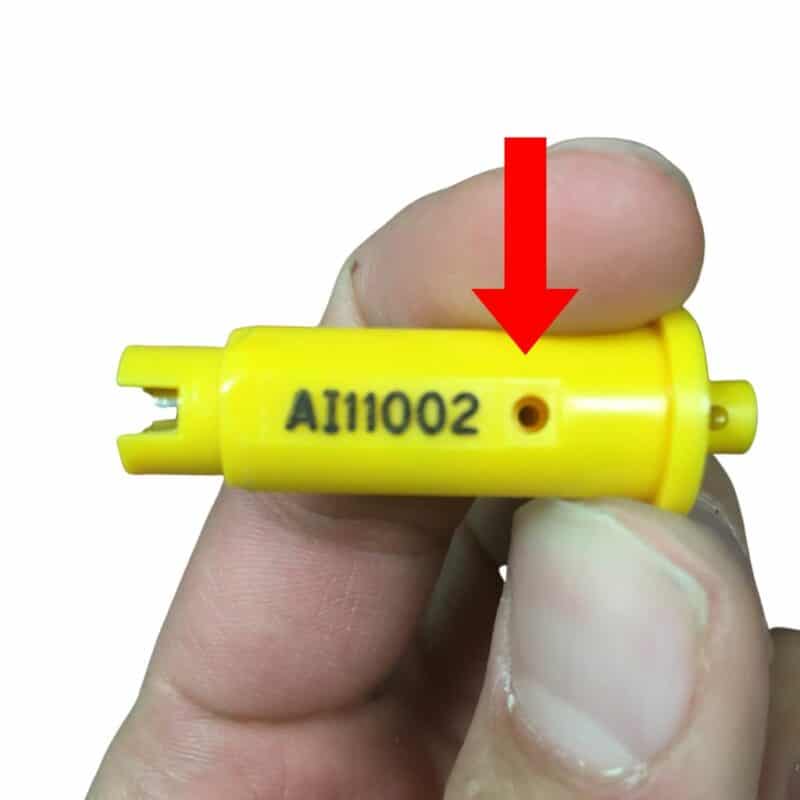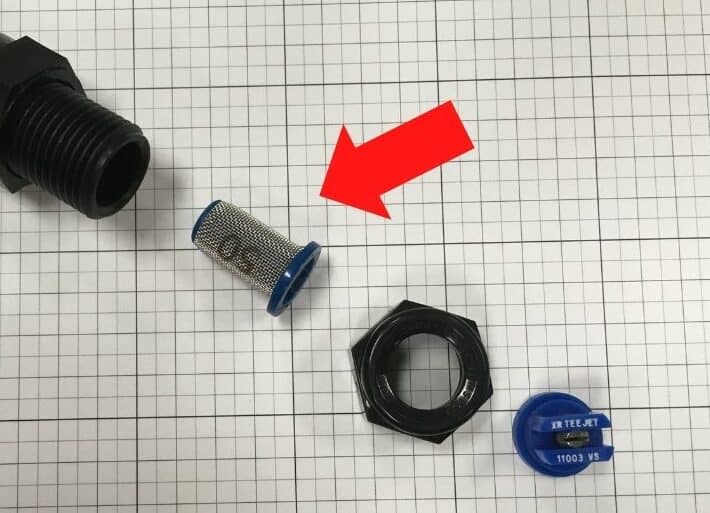You’ve got spraying to do but you cannot get your spray nozzle to work correctly! I have been there and it is frustrating. Especially when it worked just fine the last time you used it. The bottom line is what can be done to get it working again.
Sprayer nozzles come in a wide range of styles suited for different tasks. If your nozzle is not performing normally it is likely due to a plug or chemical residue, but there could be other factors at play. The solution to your problem will likely depend on the nozzle and sprayer you have as well as the type of liquid being sprayed.
Different Nozzles Types
There are several common sprayer and nozzle combinations. We will look at the possible causes and solutions that work for several of these types of nozzles:
- Hand pump sprayer and back sprayer nozzles
- Flat fan
- Cone tips
- Adjustable
- ATV/UTV spot sprayers
- Boomles
- Flood tips
- Adjustable cone
- Boom sprayers
- Flat fan
- Air induction
- Orifices/solid stream
How to Unclog & Clean Spray Nozzles
Clogs or plugs are a common cause of sprayer nozzle failure. Whether your spray nozzle is spraying a little, or not spraying at all, you likely have a plugged nozzle.
Some nozzle types are very simple and it is easy to see if they are plugged. There is simply a nozzle opening and you can visually see that the tip is blocked. Other nozzle types have more sophisticated designs to produce a certain type of spray pattern or make it adjustable. With these more elaborate nozzles, it can be difficult to tell where the plug is located.

This image shows two different nozzle types, a flat fan nozzle and an adjustable spray nozzle for a backpack, hand pump, or spot sprayer. You can see that the simple flat fan nozzle has only one area to get plugged while the adjustable nozzle is enclosed making it nearly impossible to access a plug.
Let’s examine several methods that can be used clean several different nozzle types.
Use a Plastic Pick or Toothpick
Gently insert a toothpick or plastic pick into the nozzle tip and wiggle it around to dislodge any debris. Be careful not to damage the inside of the nozzle or enlarge the tip opening, which could affect the spray pattern.
A needle, a small nail, or a pick can all work in a pinch but metal pins or needles can distort the nozzle opening and change the spray pattern. This may not be a big concern to you for spot spraying. However, if you are using a flat fan nozzle on a boom for large-scale agriculture, you need your nozzles to remain as uniform as possible to avoid streaks and uneven coverage.
Use Air
If the clog is stubborn, try using compressed air to blow it out. This can be done with a standard air compressor if you have the right attachment. A few short bursts should be adequate. It is not advisable to use your mouth to blow air into the nozzle.
If you use a boom sprayer with multiple nozzles and do a lot of spaying, a nozzle cleaning tool like this may be a good investment. You can keep it With your sprayer at all times so it’s ready to use when needed.
Flush With Water
This may seem like a waste of time because your sprayer is already trying to push water through the nozzle with no success. However, the flow rate and pressure may be inadequate to dislodge any blockage. The flow from a garden hose or spigot will be much greater and could help open up a plugged tip. Simply hold the nozzle under the spigot and run the water.
Use a Brush
Sometimes you may have flow out of your nozzle but the spray pattern is inconsistent or uneven. Chemical residue buildup can be affecting the spray pattern. You can use an old toothbrush or other small similar brush to scrub the nozzle. Use it to brush both the outside and inside.
Air induction sprayer tips are used to reduce drift. You may have this type of nozzle a boom sprayer. They are most commonly used on agricultural sprayers. If you have an air induction tip, make sure that the air induction port on the side of the nozzle is clear of debris.

Disassemble and Clean
When all else fails, resort to deep cleaning. This is especially necessary for adjustable or sophisticated nozzle designs. Many nozzles have multiple chambers inside, and you can gently take them apart. Then you can use soapy water and a soft bristle brush to scrub them gently.
After you clean them with soapy water, you should use a tank neutralizer or fresh water to rinse them off.
Finding Out Why The Nozzle Won’t Spray
A plug is the most likely cause but if unplugging the nozzle doesn’t work, there could be something systemic in your sprayer. Here are some common reasons why your sprayer nozzle may not be working even when unclogged.
Spray Wand Plugged or Damaged
If your spray nozzles are not plugged, you could still have a plug in your spray wand. Many poly handheld spray wands have screens inside to filter out debris. Over time these can get clogged up and prevent liquid from getting through.
These screens are found either in the handle or at the end of the wand. To access the screen in the handle, simply remove the hose from the wand, then unscrew the barbed end if possible. Then rinse the screen out and replace it. You can also remove the spray nozzle and see if there is a small screen at the end of the wand prior to the spray nozzle.

Occasionally the trigger portion of the spray wand can get damaged or just plain break. This usually means the valve will not close and your nozzle won’t stop spraying or it leaks. But it is possible that the trigger breaks and won’t open. This could be the reason for no liquid coming out of your spray nozzles. Unfortunately, this likely means it is time for a new spray wand.
Some more expensive, heavy-duty spray guns can be repaired. You can find more information on spray gun repair here.
Sprayer Pump Issue
A sprayer nozzle that is not working properly might be just fine. The issue could be from a lack of flow from your sprayer pump. Whether you have a hand pump sprayer, 12-volt spot sprayer, or boom sprayer, if your pump is not producing enough flow, your nozzle won’t give you the spray pattern you need.
Determining if you have a pump issue will take some troubleshooting. The type of sprayer you have will determine the specific things to check. I have written guides to troubleshooting many different sprayer types, you can find them here:
- Hand Pump Sprayer Troubleshooting
- Backpack Sprayer Troubleshooting
- ATV/12 Volt Sprayer Troubleshooting
Sprayer Nozzle Usage
Nozzles do not last forever. The spray pattern and the flow capacity will change as the nozzle wears. The shape and design of a nozzle are extremely important in getting your spray solution applied effectively and at the proper rate. For farmers and lawn care professionals, worn-out spray tips can be very costly.
Fortunately, nozzles are a relatively low-cost item for the huge impact that it has on your sprayer’s overall effectiveness. Changing out old nozzles as needed is the best way to make sure they are working properly.

